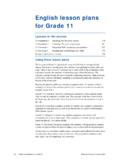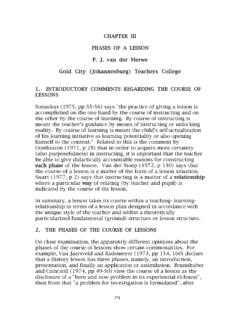Transcription of SIOP Lesson Plan Template 2 - coe.gcumedia.com
1 siop Lesson plan Template 2 2008 Pearson Education, Inc. STANDARDS: AZ Standards, Strand 4 Life Science, Concept 1: Characteristics of Organisms Understand that basic structures in plants and animals serve a function. THEME: Science Lesson TOPIC: Life Cycle of Plants OBJECTIVES: Language: Students will be able to recognize, verbalize and understand the meaning of vocabulary words associated with the life cycle of a plant: seeds, stem, soil, root, nutrients, sunlight, leaf Content: Students will observe a plant s growth from seed to mature plant Students will identify the stages within a plant s life cycle LEARNING STRATEGIES: KEY VOCABULARY: seeds, stem, soil, root, nutrients, sunlight, leaf MATERIALS: Vocabulary words, clear cups, soil, lima beans, water, chart paper, drawing paper, markers, crayons Science text and library books on plant growth MOTIVATION: (Building background) Bring in various seeds: sunflower, grass, peach, lemon, etc., and ask students to identify the type of seeds and what they will become.
2 Ask students what kinds of plants/trees are in their own yards and if they ve ever seen the seeds from which they grew. Create a KWL chart gathering student input and ideas on what they know and what they want to know about the life cycle of plants. (After the Lesson is complete and seeds have grown into plants, complete the chart with what students have learned.) Introduce key vocabulary words: seeds, stem, soil, root, nutrients, sunlight, leaf, and write on chart in front of room. PRESENTATION: (Language and content objectives, comprehensible input, strategies, interaction, feedback) The teacher will make ensure students understand the vocabulary words by referring to realia or pictures and clearly enunciating. The teacher will focus on vocabulary words and concepts by having students view pictures and use sentences supporting the meaning. The teacher will model I do, We do, You do, for students to view the processes and actions required for the activity. Students will be asked to brainstorm what plants need to live.
3 The teacher will record student siop Lesson plan Template 2 2008 Pearson Education, Inc. responses on a graphic organizer. Students will each be given a lima bean seed, soil and a clear plastic cup. The teacher will demonstrate placing soil in the cup, the seed on the inside edge of the clear plastic cup, and then, fill the cup with remaining soil. She will pour limited amount of water in the cup. After modeling this, the teacher will ask students to put soil, the lima bean, more soil and water in their cups. All cups will be placed in a sunny location. Each student will be given chart paper to write the date, illustrate their cup of soil with the lima bean visible through the clear cup. Students will observe their lima bean cups on a daily basis and record their observations for 2-3 weeks in writing and through illustrations. During the 2-3 weeks, students will record the growth of the lima bean and label their illustrations with the corresponding vocabulary words of, seeds.
4 Roots, stem, leaves, nutrients, soil, sunlight. Each day children will work in pairs to show the plant life cycle chart of illustrations and use the appropriate vocabulary words to describe the plant parts or process. This will be done verbally with key vocabulary used. PRACTICE AND APPLICATION: (Meaningful activities, interaction, strategies, practice and application, feedback) Students will be provided books to read on various plants and their life cycles in various geographic locations. In small groups, they will be asked to hypothesize why some plants can grow with little to no water and others need a lot of water. Students will work in pairs and classify plants that need little water and those that need a lot of water to grow. Students can classify, compare and contrast other features, such as: weather conditions, amount of sunlight, size of leaves, types of plants, etc. Students will predict how tall they expect their plants to be at the end of 3 weeks. The guesses will be recorded and later used to verify the predictions.
5 Students will observe the growth of their lima beans into plants and chart growth and changing features. Labels with vocabulary words will be written next to the illustration of the plant growth. After the observation period is complete, each child will present their plant, their recorded observations to the whole group REVIEW AND ASSESSMENT: (Review objectives and vocabulary, assess learning) Students will be assessed informally and formatively by the teacher through observation and questioning of recorded observations of the plant growth/life cycle. Students will be asked to create a graphic organizer and label the plant growth illustration with the corresponding vocabulary words. Summative: A final report will be written to conclude the activity and describe the life cycle of the lima bean plant. Students will present their recorded illustrations to the class and verbally describe the plant growth/life cycle using key vocabulary words. EXTENSION: (Reproduction of this material is restricted to use with Echevarria, Vogt, and Short, 2008.)
6 Making Content Comprehensible for English Learners: The siop Model.)






